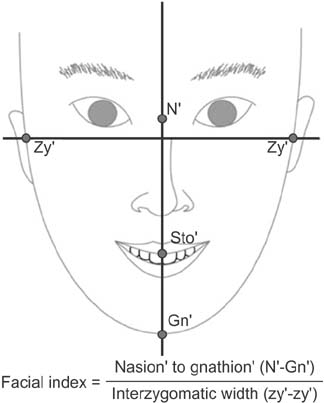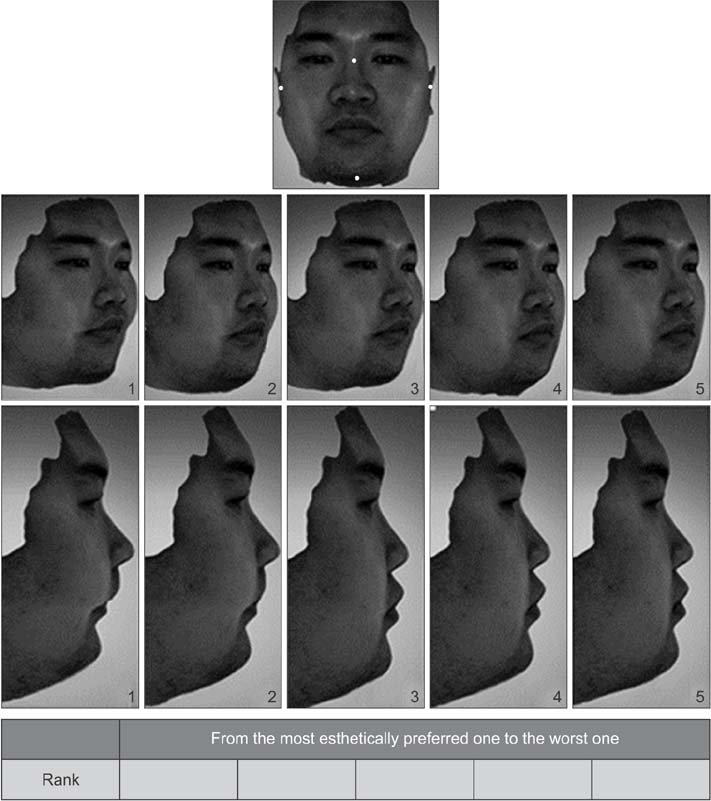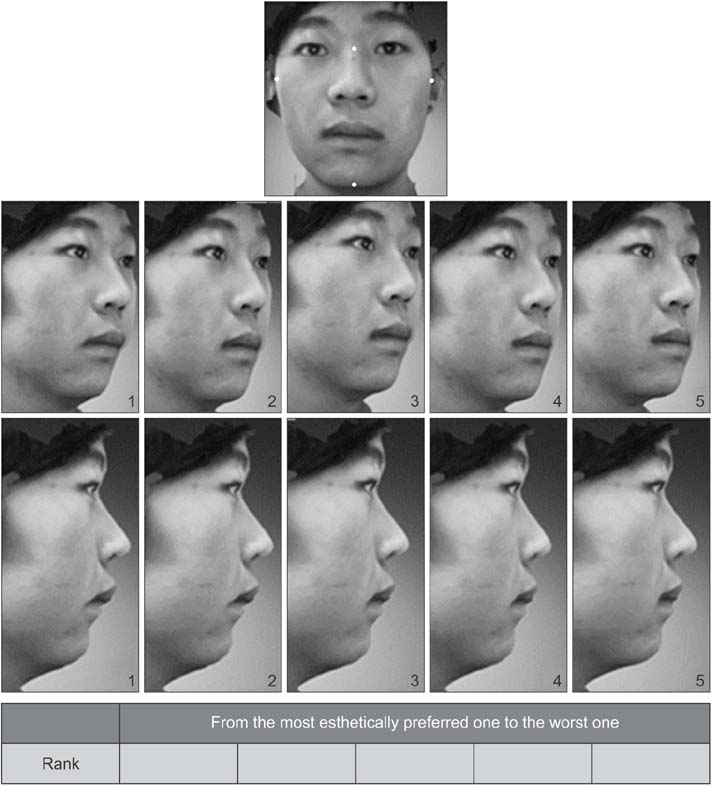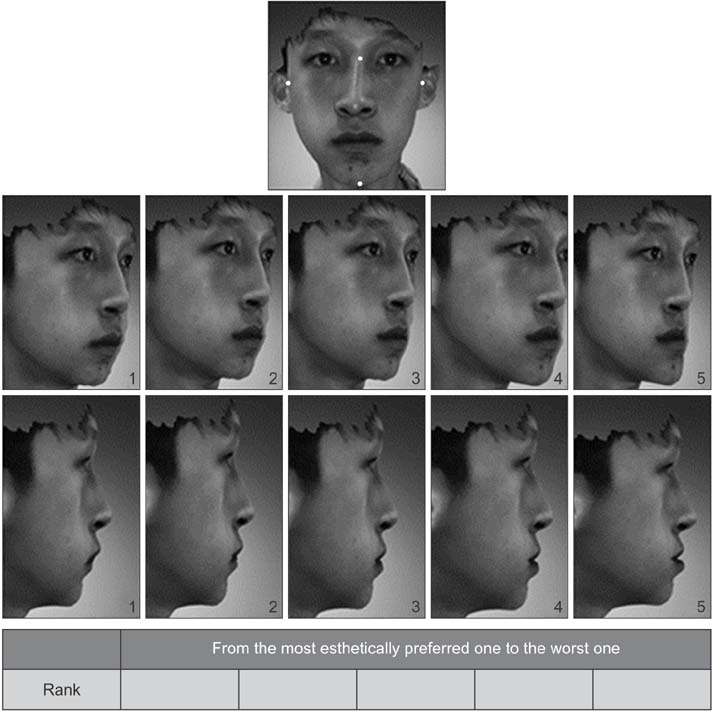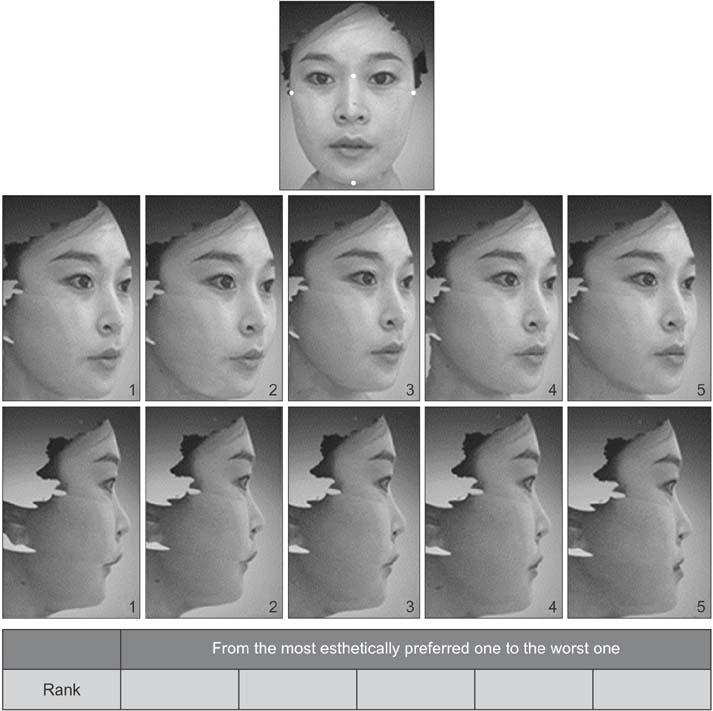Korean J Orthod.
2017 Mar;47(2):108-117. 10.4041/kjod.2017.47.2.108.
Effect of frontal facial type and sex on preferred chin projection
- Affiliations
-
- 1Department of Oral and Maxillofacial Surgery, School of Dentistry, Seoul National University, Seoul, Korea.
- 2Dental Research Institute, Seoul National University, Seoul, Korea. drwhite@unitel.co.kr
- 3Department of Oral and Maxillofacial Surgery, Soonchunhyang University Bucheon Hospital, Bucheon, Korea.
- 4Private Practice, Busan, Korea.
- 5Private Practice, Pohang, Korea.
- 6Department of Orthodontics, School of Dentistry, Seoul National University, Seoul, Korea.
- KMID: 2400388
- DOI: http://doi.org/10.4041/kjod.2017.47.2.108
Abstract
OBJECTIVE
To investigate the effects of frontal facial type (FFT) and sex on preferred chin projection (CP) in three-dimensional (3D) facial images.
METHODS
Six 3D facial images were acquired using a 3D facial scanner (euryprosopic [Eury-FFT], mesoprosopic [Meso-FFT], and leptoprosopic [Lepto-FFT] for each sex). After normal CP in each 3D facial image was set to 10° of the facial profile angle (glabella-subnasale-pogonion), CPs were morphed by gradations of 2° from normal (moderately protrusive [6°], slightly protrusive [8°], slightly retrusive [12°], and moderately retrusive [14°]). Seventy-five dental students (48 men and 27 women) were asked to rate the CPs (6°, 8°, 10°, 12°, and 14°) from the most to least preferred in each 3D image. Statistical analyses included the Kolmogorov-Smirnov test, Kruskal-Wallis test, and Bonferroni correction.
RESULTS
No significant difference was observed in the distribution of preferred CP in the same FFT between male and female evaluators. In Meso-FFT, the normal CP was the most preferred without any sex difference. However, in Eury-FFT, the slightly protrusive CP was favored in male 3D images, but the normal CP was preferred in female 3D images. In Lepto-FFT, the normal CP was favored in male 3D images, whereas the slightly retrusive CP was favored in female 3D images. The mean preferred CP angle differed significantly according to FFT (Eury-FFT: male, 8.7°, female, 9.9°; Meso-FFT: male, 9.8°, female, 10.7°; Lepto-FFT: male, 10.8°, female, 11.4°; p < 0.001).
CONCLUSIONS
Our findings might serve as guidelines for setting the preferred CP according to FFT and sex.
Figure
Reference
-
1. Proffit WR, Phillips C, Douvartzidis N. A comparison of outcomes of orthodontic and surgical-orthodontic treatment of Class II malocclusion in adults. Am J Orthod Dentofacial Orthop. 1992; 101:556–565.
Article2. Peck H, Peck S. A concept of facial esthetics. Angle Orthod. 1970; 40:284–318.3. Koury ME, Epker BN. Maxillofacial esthetics: anthropometrics of the maxillofacial region. J Oral Maxillofac Surg. 1992; 50:806–820.
Article4. Pettijohn TF 2nd, Jungeberg BJ. Playboy Playmate curves: changes in facial and body feature preferences across social and economic conditions. Pers Soc Psychol Bull. 2004; 30:1186–1197.
Article5. Bergman RT. Cephalometric soft tissue facial analysis. Am J Orthod Dentofacial Orthop. 1999; 116:373–389.
Article6. Arnett GW, Bergman RT. Facial keys to orthodontic diagnosis and treatment planning--Part II. Am J Orthod Dentofacial Orthop. 1993; 103:395–411.
Article7. Coleman GG, Lindauer SJ, Tüfekçi E, Shroff B, Best AM. Influence of chin prominence on esthetic lip profile preferences. Am J Orthod Dentofacial Orthop. 2007; 132:36–42.
Article8. Alcalde RE, Jinno T, Orsini MG, Sasaki A, Sugiyama RM, Matsumura T. Soft tissue cephalometric norms in Japanese adults. Am J Orthod Dentofacial Orthop. 2000; 118:84–89.
Article9. Denize ES, McDonald F, Sherriff M, Naini FB. Facial profile parameters and their relative influence on bilabial prominence and the perceptions of facial profile attractiveness: a novel approach. Korean J Orthod. 2014; 44:184–194.
Article10. Toureno L, Kook YA, Bayome M, Park JH. The effect of western adaptation of Hispanic-Americans on their assessment of Korean facial profiles. Korean J Orthod. 2014; 44:28–35.
Article11. Farkas LG, Munro IR. Anthropometric facial proportions in medicine. Springfield: Thomas Publisher;1986.12. Rakosi T, Jonas I, Graber TM. Orthodontic diagnosis. New York: Thieme Medical Publishers;1993.13. Sicher H, DuBrul EL. Oral anatomy. 6th ed. St. Louis: Mosby;1975.14. Franco FC, de Araujo TM, Vogel CJ, Quintão CC. Brachycephalic, dolichocephalic and mesocephalic: Is it appropriate to describe the face using skull patterns? Dental Press J Orthod. 2013; 18:159–163.
Article15. Martin R, Saller K. Lehrbuch der anthropologie, in systematischer darstellung. Stuttgart: Gustav Fischer Verlag;1957.16. Maple JR, Vig KW, Beck FM, Larsen PE, Shanker S. A comparison of providers' and consumers' perceptions of facial-profile attractiveness. Am J Orthod Dentofacial Orthop. 2005; 128:690–696.
Article17. Cochrane SM, Cunningham SJ, Hunt NP. A comparison of the perception of facial profile by the general public and 3 groups of clinicians. Int J Adult Orthodon Orthognath Surg. 1999; 14:291–295.18. Soh J, Chew MT, Wong HB. A comparative assessment of the perception of Chinese facial profile esthetics. Am J Orthod Dentofacial Orthop. 2005; 127:692–699.
Article19. Chong HT, Thea KW, Descallar J, Chen Y, Dalci O, Wong R, et al. Comparison of White and Chinese perception of esthetic Chinese lip position. Angle Orthod. 2014; 84:246–253.
Article20. Shimomura T, Ioi H, Nakata S, Counts AL. Evaluation of well-balanced lip position by Japanese orthodontic patients. Am J Orthod Dentofacial Orthop. 2011; 139:e291–e297.
Article21. Foos PW, Clark MC. Adult age and gender differences in perceptions of facial attractiveness: beauty is in the eye of the older beholder. J Genet Psychol. 2011; 172:162–175.
Article22. Naini FB, Donaldson AN, McDonald F, Cobourne MT. Assessing the influence of lower facial profile convexity on perceived attractiveness in the orthognathic patient, clinician, and layperson. Oral Surg Oral Med Oral Pathol Oral Radiol. 2012; 114:303–311.
Article23. Modarai F, Donaldson JC, Naini FB. The influence of lower lip position on the perceived attractiveness of chin prominence. Angle Orthod. 2013; 83:795–800.
Article24. Marchetti C, Bianchi A, Muyldermans L, Di Martino M, Lancellotti L, Sarti A. Validation of new soft tissue software in orthognathic surgery planning. Int J Oral Maxillofac Surg. 2011; 40:26–32.
Article25. Plooij JM, Maal TJ, Haers P, Borstlap WA, Kuijpers-Jagtman AM, Bergé SJ. Digital three-dimensional image fusion processes for planning and evaluating orthodontics and orthognathic surgery. A systematic review. Int J Oral Maxillofac Surg. 2011; 40:341–352.
Article26. Bell R, Kiyak HA, Joondeph DR, McNeill RW, Wallen TR. Perceptions of facial profile and their influence on the decision to undergo orthognathic surgery. Am J Orthod. 1985; 88:323–332.
Article27. Dunlevy HA, White RP Jr, Turvey TA. Professional and lay judgment of facial esthetic changes following orthognathic surgery. Int J Adult Orthodon Orthognath Surg. 1987; 2:151–158.28. Kerr WJ, O'Donnell JM. Panel perception of facial attractiveness. Br J Orthod. 1990; 17:299–304.
Article29. Prahl-Andersen B, Boersma H, van der Linden FP, Moore AW. Perceptions of dentofacial morphology by laypersons, general dentists, and orthodontists. J Am Dent Assoc. 1979; 98:209–212.
Article30. Shelly AD, Southard TE, Southard KA, Casko JS, Jakobsen JR, Fridrich KL, et al. Evaluation of profile esthetic change with mandibular advancement surgery. Am J Orthod Dentofacial Orthop. 2000; 117:630–637.
Article31. Mantzikos T. Esthetic soft tissue profile preferences among the Japanese population. Am J Orthod Dentofacial Orthop. 1998; 114:1–7.
Article32. Park NS, Park JH, Bayome M, Mo SS, Kim Y, Kook YA. An evaluation of preferred lip positions according to different age groups. Int J Oral Maxillofac Surg. 2013; 42:637–642.
Article
- Full Text Links
- Actions
-
Cited
- CITED
-
- Close
- Share
- Similar articles
-
- A study of esthetic facial profile preference in Korean
- Posteroanterior cephalometric study of frontal ramal inclination in chin-deviated individuals
- Level of perception related to changes in lower facial height
- A Study on Preferred Morphologic Feature and Proportion of Facial Aesthetic Subunit by Korean General Public
- Correction of mandibular ramus height with frontal and lateral ramal inclinations in cephalograms and its effects on diagnostic accuracy of asymmetry

